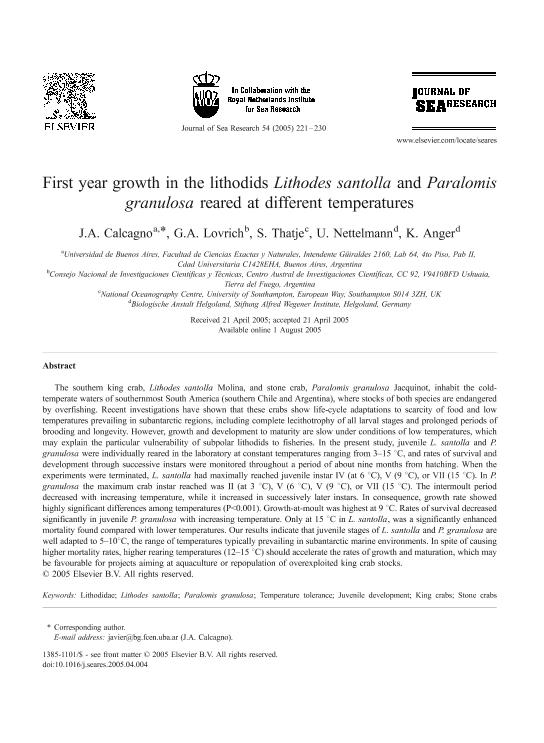Artículo
First year growth in the lithodids Lithodes santolla and Paralomis granulosa reared at different temperatures
Fecha de publicación:
10/2005
Editorial:
Elsevier Science
Revista:
Journal of Sea Research
ISSN:
1385-1101
Idioma:
Inglés
Tipo de recurso:
Artículo publicado
Clasificación temática:
Resumen
The southern king crab, Lithodes santolla Molina, and stone crab, Paralomis granulosa Jacquinot, inhabit the coldtemperatewaters of southernmost South America (southern Chile and Argentina), where stocks of both species are endangeredby overfishing. Recent investigations have shown that these crabs show life-cycle adaptations to scarcity of food and lowtemperatures prevailing in subantarctic regions, including complete lecithotrophy of all larval stages and prolonged periods ofbrooding and longevity. However, growth and development to maturity are slow under conditions of low temperatures, whichmay explain the particular vulnerability of subpolar lithodids to fisheries. In the present study, juvenile L. santolla and P.granulosa were individually reared in the laboratory at constant temperatures ranging from 3–15 8C, and rates of survival anddevelopment through successive instars were monitored throughout a period of about nine months from hatching. When theexperiments were terminated, L. santolla had maximally reached juvenile instar IV (at 6 8C), V (9 8C), or VII (15 8C). In P.granulosa the maximum crab instar reached was II (at 3 8C), V (6 8C), V (9 8C), or VII (15 8C). The intermoult perioddecreased with increasing temperature, while it increased in successively later instars. In consequence, growth rate showedhighly significant differences among temperatures (Pb0.001). Growth-at-moult was highest at 9 8C. Rates of survival decreasedsignificantly in juvenile P. granulosa with increasing temperature. Only at 15 8C in L. santolla, was a significantly enhancedmortality found compared with lower temperatures. Our results indicate that juvenile stages of L. santolla and P. granulosa arewell adapted to 5–108C, the range of temperatures typically prevailing in subantarctic marine environments. In spite of causinghigher mortality rates, higher rearing temperatures (12–15 8C) should accelerate the rates of growth and maturation, which maybe favourable for projects aiming at aquaculture or repopulation of overexploited king crab stocks.
Archivos asociados
Licencia
Identificadores
Colecciones
Articulos(CADIC)
Articulos de CENTRO AUSTRAL DE INVESTIGACIONES CIENTIFICAS
Articulos de CENTRO AUSTRAL DE INVESTIGACIONES CIENTIFICAS
Citación
Calcagno, Javier Ángel; Lovrich, Gustavo Alejandro; Thatje, S.; Nettelmann, U.; Anger, K.; First year growth in the lithodids Lithodes santolla and Paralomis granulosa reared at different temperatures; Elsevier Science; Journal of Sea Research; 54; 3; 10-2005; 221-230
Compartir
Altmétricas




